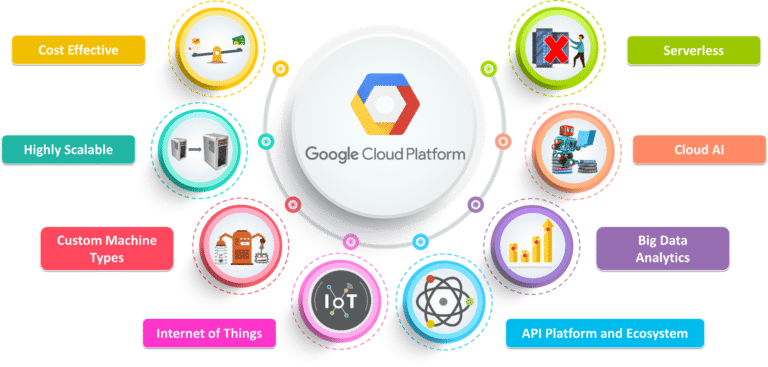Google Cloud Platform
Google Cloud Professional Services Organisation
Google Cloud Platform: Overview
Google Cloud Platform (GCP), offered by Google, is a suite of cloud computing services that runs on the same infrastructure that Google uses internally for its end-user products, such as Google Search, Gmail, Google Drive, and YouTube. Alongside a set of management tools, it provides a series of modular cloud services including computing, data storage, data analytics, and machine learning. Registration requires credit card or bank account details.
Google Cloud Platform provides infrastructure as a service, platform as a service, and serverless computing environments.


In April 2008, Google announced App Engine, a platform for developing and hosting web applications in Google-managed data centers, which was the first cloud computing service from the company. The service became generally available in November 2011. Since the announcement of App Engine, Google has added multiple cloud services to the platform.
Google Cloud Platform is a part of Google Cloud, which includes the Google Cloud Platform public cloud infrastructure, as well as Google Workspace (G Suite), enterprise versions of Android and Chrome OS, and application programming interfaces (APIs) for machine learning and enterprise mapping services.


Google Workspace (formerly known as Google Apps and later G Suite) is a collection of cloud computing, productivity, and collaboration tools, software, and products developed and marketed by Google. It was first launched in 2006 as Google Apps for Your Domain and rebranded as G Suite in 2016. Google Workspace consists of Gmail, Contacts, Calendar, Meet and Chat for communication; Currents for employee engagement; Drive for storage and the Google Docs suite for content creation. An Admin Panel is provided for managing users and services. Depending on the edition Google Workspace may also include the digital interactive whiteboard Jamboard and an option to purchase such add-ons as the telephony service Voice. The education edition adds a learning platform Google Classroom and today has the name Workspace for Education.
While most of these services are individually available at no cost to consumers who use their free Google (Gmail) accounts, Google Workspace adds enterprise features such as custom email addresses at a domain (e.g. @yourcompany.com), an option for unlimited Drive storage, additional administrative tools and advanced settings, as well as 24/7 phone and email support.
Being based in Google’s data centers, data and information are saved directly and then synchronized to other data centers for backup purposes. Unlike the free, consumer-facing services, Google Workspace users do not see advertisements while using the services, and information and data in Google Workspace accounts do not get used for advertisement purposes. Furthermore, Google Workspace administrators can fine-tune security and privacy settings.
In June 2021, Google announced that Workspace would be available “for everyone” with a Google Account, giving consumers access to the upgraded Gmail experience previously only available to paying subscribers.
As of April 2020, G Suite had 6 million paying businesses and 120 million G Suite for Education users.
Google Cloud’s Professional Services Organization (PSO) engages with customers to ensure effective and efficient operations in the cloud, from the time they begin considering how the cloud can help them overcome their operational, business, or technical challenges, to the time they’re looking to optimize their cloud workloads.
We know that all parts of the cloud journey are important and can be complex. In this blog post, we want to focus specifically on the migration process and how PSO engages in a myriad of activities to ensure a successful migration.
As a team of trusted technical advisors, PSO will approach migrations in three phases:
- Pre-Migration Planning
- Cutover Activities
- Post-Migration Operations
While this post will not cover in detail all of the steps required for a migration, it will focus on how PSO engages in specific activities to meet customer objectives, manage risk, and deliver value. We will discuss the assets, processes, and tools that we leverage to ensure success.
As an IT administrator for a business or school, you can deploy enterprise features for Chrome users across a range of devices—Windows®, Mac®, and Linux® computers, Chromebooks, and other devices that run the Chrome operating system.
Manage Chrome Browser
Deploy Chrome Browsers across your organization’s Windows, Mac, and Linux computers. Then use your preferred IT tools to enforce policies across devices, install business apps and extensions, and manage other enterprise features of Chrome.
Manage Chrome devices
You can also manage policies on devices that run Chrome as an operating system. These devices include Chromebooks used as work computers. They also include Chromeboxes or Chromebits used for digital signage or single-purpose kiosk apps.
Enforce 300+ corporate policies
Whether you manage Chrome Browsers or Chrome devices, you can enforce a wide range of policies:
- Allowlist or blocklist apps and site URLs
- Enforce privacy and security policies
- Install and manage business apps and extensions
- Manage Chrome auto-updates
This year at Google I/O, we announced the general availability of Cloud-based maps styling for the Maps JavaScript API. In an effort to provide you with more options and more control to help create the best experience for your users, today we’re releasing new features to Cloud-based maps styling. You may already be familiar with these features from the consumer Google Maps web and mobile apps—Landmarks and Building Footprints. We’re also releasing updates to our industry optimized map styles to provide even more map details while providing the flexibility to craft the best experience for your users
